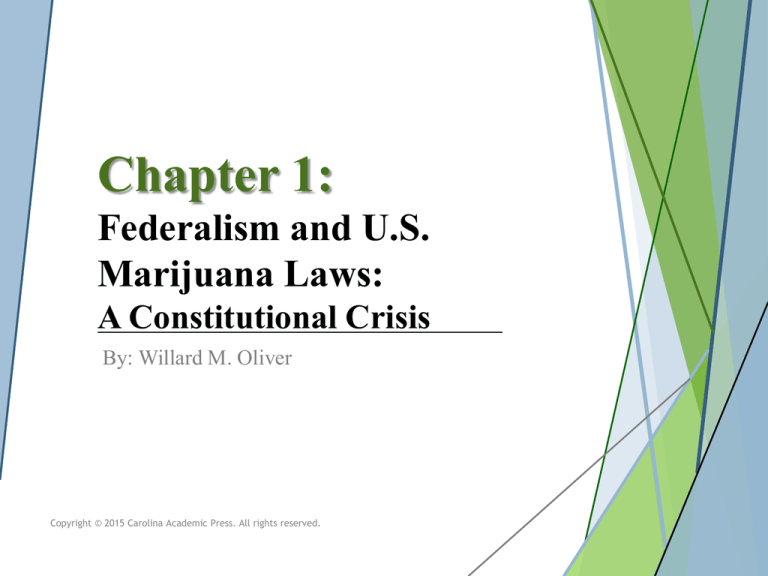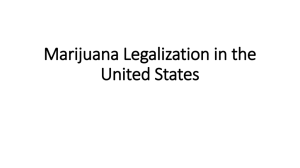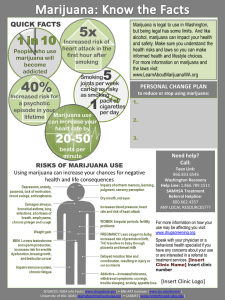
Chapter 1:
Federalism and U.S.
Marijuana Laws:
A Constitutional Crisis
By: Willard M. Oliver
Copyright © 2015 Carolina Academic Press. All rights reserved.
Introduction
17 states and the District of Columbia have
decriminalized marijuana
23 states and the District of Columbia legalized
medicinal marijuana
4 states and the District of Columbia legalized
recreational use of marijuana
Washington D.C. despite laws continues to enforce the
federal law that lists marijuana as a Schedule I narcotic
Most significant federal crisis in modern times
Copyright © 2015 Carolina Academic Press. All rights reserved.
History of Marijuana in the U.S.
Use of marijuana dates back to colonial era
o Not smoked for medical or recreational purposes
o Used as food product
o Used for making ropes and fabrics
Marijuana derived from Hemp Plant
o Indigenous to Central and South Asia
Use for recreational purposes appears to have been
derived from the Spaniards
Use of drug migrated north with the Mexicans and
individuals from the Caribbean (free islanders and
African slaves)
Copyright © 2015 Carolina Academic Press. All rights reserved.
History of Marijuana in the U.S.
(Cont’d)
Before the late 19th century marijuana largely seen as a
cultural and underground phenomenon
In the late 19th and early 20th centuries marijuana was
largely associated with Hispanics and Blacks
o Mexicans
•
Practitioners of Voodoo
•
Those associated with jazz movement
o Concerns raised on the over mass of immigration and the
American culture fundamentals beginning to change
Copyright © 2015 Carolina Academic Press. All rights reserved.
History of Marijuana in the U.S.
(Cont’d)
Action by the federal government
o Pure food and Drug Act of 1906
•
Marijuana increasingly being labeled as a poison in the late
19th century
o Congress
•
•
Added cannabis to the list of “dangerous” drugs
Required labeling of all prescription drugs, including marijuana
California was the first state to pass legislation
regulating marijuana
o Poison Act in 1907
Massachusetts in 1911 was the first to outlaw marijuana
outright
Copyright © 2015 Carolina Academic Press. All rights reserved.
History of Marijuana in the U.S.
(Cont’d)
When alcohol was made illegal by the Prohibition
individuals were looking for an alternative drug
Uniform policy
o 1925 – International Opium Convention
•
Ban on hashish
o 1925 - National Conference of Commissioners on Uniform
State Laws
•
Uniform State Narcotic Act – Congress accepted the final draft
as model legislation for regulating drugs
o 1935 – every state in the nation had signed on to the
uniform standards
Copyright © 2015 Carolina Academic Press. All rights reserved.
History of Marijuana in the U.S.
(Cont’d)
1930 – Congress consolidated the Federal Narcotics
Control Board and the Narcotics Division of U.S. Treasury
to create the Federal Bureau of Narcotics (FBN)
o Commissioner – Harry J. Anslinger – focused much of his
time on marijuana
•
Launched campaign to demonize marijuana
•
Civil and church groups became actively involved
•
Movies were used to convey anti-marijuana message
Congress passed the Marihuana Tax Act in 1937
o Did not criminalize the possession or use of marijuana
o Placed tax on anyone selling marijuana
o Imposed heavy fines for anyone violating the law
Copyright © 2015 Carolina Academic Press. All rights reserved.
History of Marijuana in the U.S.
(Cont’d)
1960s – baby boom
1970s – generation began challenging institutions
o Smoking marijuana became symbol of their generation
Late 1960s and early 1970s Nixon Administration took a
hardline approach to marijuana
o Controlled Substances Act, Title II of the Comprehensive
Drug Abuser Prevention and Control Act
•
Placed drugs into different categories, called Schedules
•
Marijuana identified as a Schedule I drug (no recognized
medical benefits and high potential for abuse)
Copyright © 2015 Carolina Academic Press. All rights reserved.
Federalism
Conflict that arose in the 1970s is between the national
government and state governments
National government given enumerated powers
o Creation of military
o Printing of U.S. currency
Powers reserved for state governments
o Conduct of elections
o Establishment of local governments
Shared powers of governance
o Establishment of courts
o Chartering banks
o Making and enforcing laws
Copyright © 2015 Carolina Academic Press. All rights reserved.
Federalism (Cont’d)
Framers of the Constitution could not allocate responsibility for
every issue at the time or for the future
o Provided a framework of governance for national and state
governments to collaborate
Constitutions vague in specifying responsibilities
o 10th Amendment designed to address deficiency, “the powers not
delegated to the United States by the Constitution, nor prohibited
by it to the states, are reserved to the states respectively, or to the
people”
o Constitution does not mentioned regulating drug for medicinal or
recreational purposes therefor it is left for the states to decide
o “supremacy clause”
•
“This Constitution, and the Laws of the United States which shall be made
in Pursuance thereof; and all Treaties made, or which shall be made,
under the Authority of the United States, shall be the supreme Law of the
Land”
Copyright © 2015 Carolina Academic Press. All rights reserved.
The full set of PowerPoint slides is
available upon adoption.
Email bhall@cap-press.com
for more information.



![[H1]Researching Society with MicroCase Online](http://s3.studylib.net/store/data/007737973_2-9d35b9e42208c660471ccaa373bd3b78-300x300.png)




